Introduction
Understanding and detecting autism spectrum disorder (ASD) in children is a crucial part of their well-being and development. One key screening tool used in this process is the Modified Checklist for Autism in Toddlers-Revised with Follow-Up (M-CHAT). This parent-completed questionnaire is designed to identify children at risk for ASD as early as 18 to 24 months.
However, research has shown that the tool's effectiveness can vary in real-world settings, particularly among girls and children of color. This article explores the role of the M-CHAT in early detection, the importance of early screening, the limitations of the tool, and the next steps after a positive or negative result. It also provides tips for parents, addresses frequently asked questions, and highlights the need for professional evaluation and ongoing monitoring.
By staying informed and advocating for their children, parents can ensure timely interventions and support for their child's unique developmental journey.
Understand the M-CHAT
Understanding the M-CHAT and Its Role in Autism Detection
During routine pediatric visits, parents often engage in discussions about their child's developmental progress, such as milestones in walking, talking, and social interactions. With autism affecting communication, behavior, and learning across a broad spectrum, early screening has become a critical part of these healthcare check-ups. One key screening tool used to detect early signs of autism is the Modified Checklist for Autism in Toddlers-Revised with Follow-Up (M-CHAT-R/F).
The M-CHAT, a parent-completed questionnaire, is designed to identify children at risk for autism spectrum disorder (ASD) as early as 18 to 24 months. Research has demonstrated that the M-CHAT-R/F is more accurate in controlled studies than in typical primary care settings, highlighting the need for meticulous follow-up and interpretation. Despite its higher accuracy in research environments, studies have revealed that the tool's sensitivity can be low in real-world applications, particularly among girls and children of color.
Innovative technologies and digital health products are being developed to supplement traditional screening methods like the M-CHAT. These digital biomarkers collect behavioral and physiological data, offering additional insights into a child's development, potentially leading to more accurate and objective screening outcomes. By incorporating these advancements, healthcare providers can improve the detection of ASD and facilitate timely interventions, which are crucial for the child's long-term well-being.
The M-CHAT's role extends beyond initial screening; it serves as a conduit for further evaluation and diagnosis. A positive screen necessitates a referral to specialists who can conduct comprehensive assessments. Ultimately, the M-CHAT is a vital component in the broader strategy to ensure early identification and support for children with autism, enabling access to resources that promote their health and development.
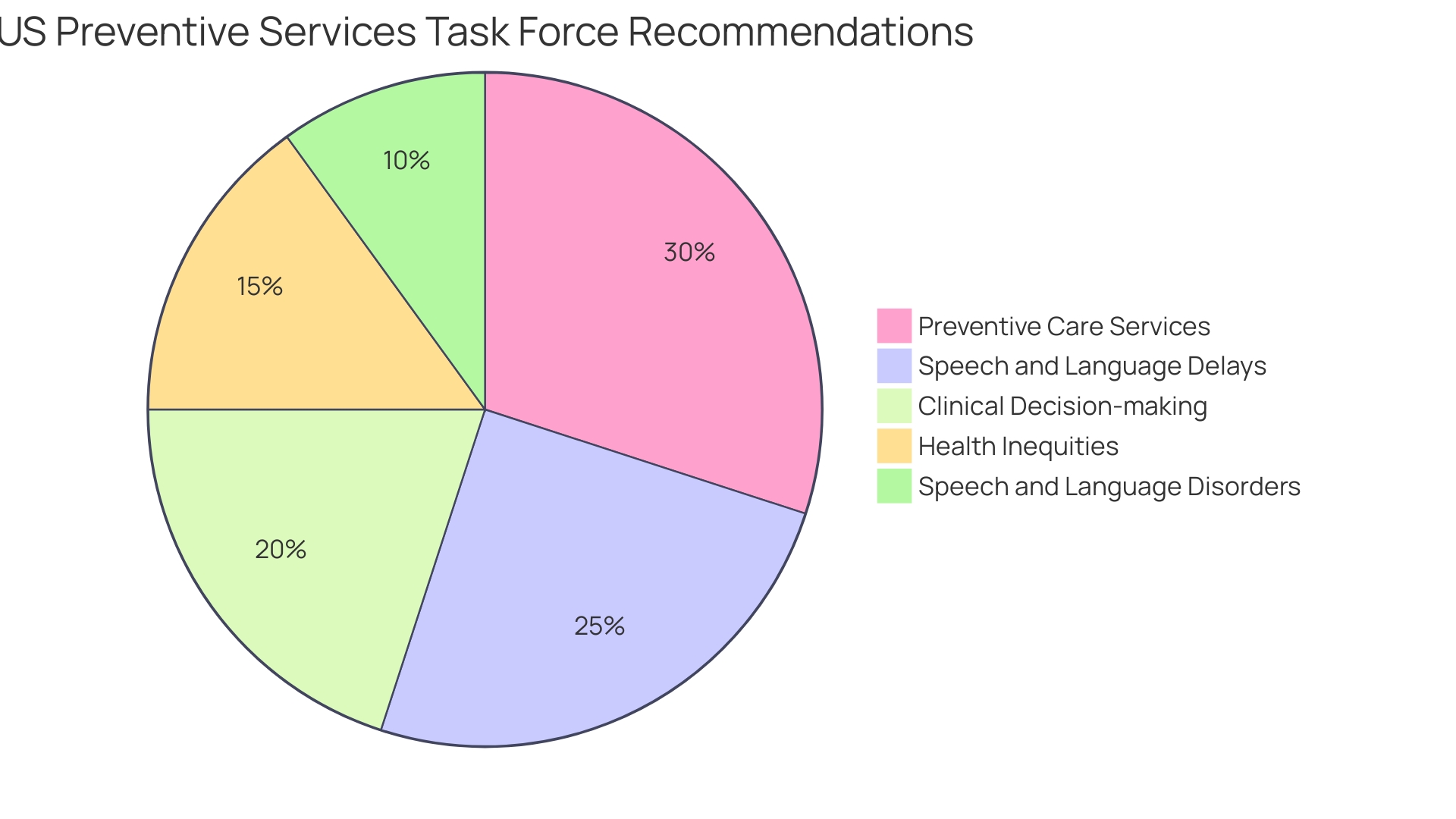
Know the Importance of Early Autism Screening
Early autism screening plays a crucial role in a child's development, potentially altering their trajectory in profoundly positive ways. With autism affecting 1 in 36 children, according to the Centers for Disease Control and Prevention, early detection becomes not just beneficial, but essential. Early signs of autism may include a lack of eye contact or failure to respond to their name by 9 months old.
Detecting these signs promptly can lead to early intervention, which has been shown to significantly impact a child's ability to communicate and interact socially.
Groundbreaking research, including studies published in JAMA Network Open and the Journal of the American Medical Association, has developed automated technologies that analyze children's social visual engagement. These tools measure eye movements while children watch videos, capturing how they process social information. Such innovations have led to the creation of diagnostic tools like the 'Marcus Test', which can predict autism diagnoses with a reported 98.5% accuracy in early trials.
The significance of these advancements cannot be overstated. Dr. Warren Jones of the Marcus Autism Center highlights the importance of early intervention in supporting not just immediate health, but the long-term well-being and learning capabilities of children with autism. With early and accurate diagnosis, children can begin receiving the support they need far sooner, avoiding the often lengthy and stressful diagnostic process that families typically endure.
Clinical decisions, as noted by the US Preventive Services Task Force (USPSTF), should be informed by evidence but also tailored to each child's unique situation. This approach ensures that every child receives the individualized care they deserve, without the constraints of cost considerations impeding access to necessary services. By embracing these innovative diagnostic methods and personalized care strategies, we can better support the diverse needs of children with autism and their families, making strides toward equitable health outcomes for all.
Identify Who Should Use the M-CHAT
To identify early signs of autism, healthcare providers are increasingly incorporating specific screening tools into routine pediatric visits for young children. The Modified Checklist for Autism in Toddlers-Revised with Follow-Up (M-CHAT-R/F) is one such tool designed to detect autism spectrum disorder (ASD) symptoms in toddlers between 18 and 24 months old. The M-CHAT-R/F's effectiveness, however, has shown variability outside of research settings, especially among girls and children of color, prompting a call for more accurate and equitable screening methods.
The urgency for early and accurate autism detection is underscored by the profound difference early intervention can make. It is reported that earlier access to behavioral therapies can lead to significantly improved outcomes for children with ASD. Organizations like The Autism Community in Action (TACA) support this approach, providing resources to thousands of families and endorsing the importance of early treatment.
While the neurodivergent community acknowledges the validity of self-diagnosis, given the challenges and limitations of medical testing, the benefits of an official diagnosis can include access to tailored support and services. As research advances, digital health tools are emerging as potential aids in the diagnostic process, offering scalability and the ability to gather ecological data from a child's natural environment. These digital biomarkers could revolutionize the way autism is diagnosed, making the process more objective and efficient.
In view of the disparities in the current diagnostic landscape, and the potential of novel strategies, it is crucial for healthcare providers to be well-informed and for parents to be proactive in seeking evaluations that could pave the way to vital early intervention for their children.
Familiarize Yourself with How the M-CHAT Works
Understanding the nuances of the M-CHAT screening process is crucial. This parent questionnaire, the Modified Checklist for Autism in Toddlers-Revised with Follow-Up (M-CHAT-R/F), is typically used during 18–24-month well-child visits. It's designed to uncover early signs of autism spectrum disorder (ASD) by asking specific questions about a child's behavior and development.
The scoring system helps to determine the likelihood of ASD, and the results guide whether further evaluation is recommended.
Despite its widespread use, the M-CHAT-R/F's effectiveness varies. Research shows that in clinical settings, it performs well, but in real-world applications like primary care, accuracy drops, especially for girls and children of color. A significant study involving over 25,000 children highlighted that while the specificity of the M-CHAT-R/F was 95%, its sensitivity was only 39%, with a positive predictive value of 14.6%.
This discrepancy points to a need for more precise, objective, and scalable autism screening tools.
The importance of early detection and intervention cannot be overstated. With approximately 1 in 36 US children affected by autism, and many parents reporting developmental concerns before their child reaches two years old, the timeliness of diagnosis is critical. Unfortunately, the median age for an autism diagnosis in the U.S. is still between 4 to 5 years, which can delay vital early interventions.
Digital health products, including mobile apps, show promise in supporting the diagnostic process. These tools can collect valuable behavioral and physiological data, providing clinicians with additional ecological information from a child's home environment.
As we move forward, the development of digital biomarkers and the integration of cognitive and behavioral assessments are seen as promising steps towards more precise diagnoses and tailored treatments. For parents, understanding the M-CHAT process and its current limitations is the first step towards advocating for early and accurate assessment of their child's development.
Recognize the Role of the Follow-Up Interview
The M-CHAT (Modified Checklist for Autism in Toddlers) screening process is a critical early step in identifying potential signs of autism spectrum disorder (ASD), a neurodevelopmental condition characterized by diverse communication and behavioral challenges. The follow-up interview after an initial M-CHAT screening is not merely a formality; it serves as an essential component in interpreting the nuances of a child's development. This secondary conversation enables healthcare providers to delve deeper into the initial responses, ensuring that any red flags for ASD are not overlooked.
In fact, according to the US Preventive Services Task Force, early intervention offers substantial benefits, underscoring the importance of accurate and timely screening.
Through this personalized dialogue, parents and caregivers can provide context to their child's behaviors and actions, which may not be readily apparent in a questionnaire format. By engaging in a detailed follow-up interview, pediatricians can capture a richer, more comprehensive portrait of the child's abilities and challenges. This refined understanding is particularly vital given that autism is known for its wide spectrum of manifestations, which can range from subtle to more pronounced.
Moreover, the significance of early detection through reliable screening methods such as the M-CHAT cannot be overstated. Research from The Autism Community in Action (TACA) indicates that the earlier behavioral therapy and support commence, the more favorable the outcomes for the child. By meticulously clarifying M-CHAT results through follow-up interviews, healthcare providers can expedite referrals for further evaluation and intervention, potentially altering the trajectory of a child's development.
In essence, the follow-up interview is a cornerstone of the M-CHAT screening, sharpening the focus on each child's unique developmental journey and ensuring that every nuance is considered in the pursuit of fostering their growth and well-being.
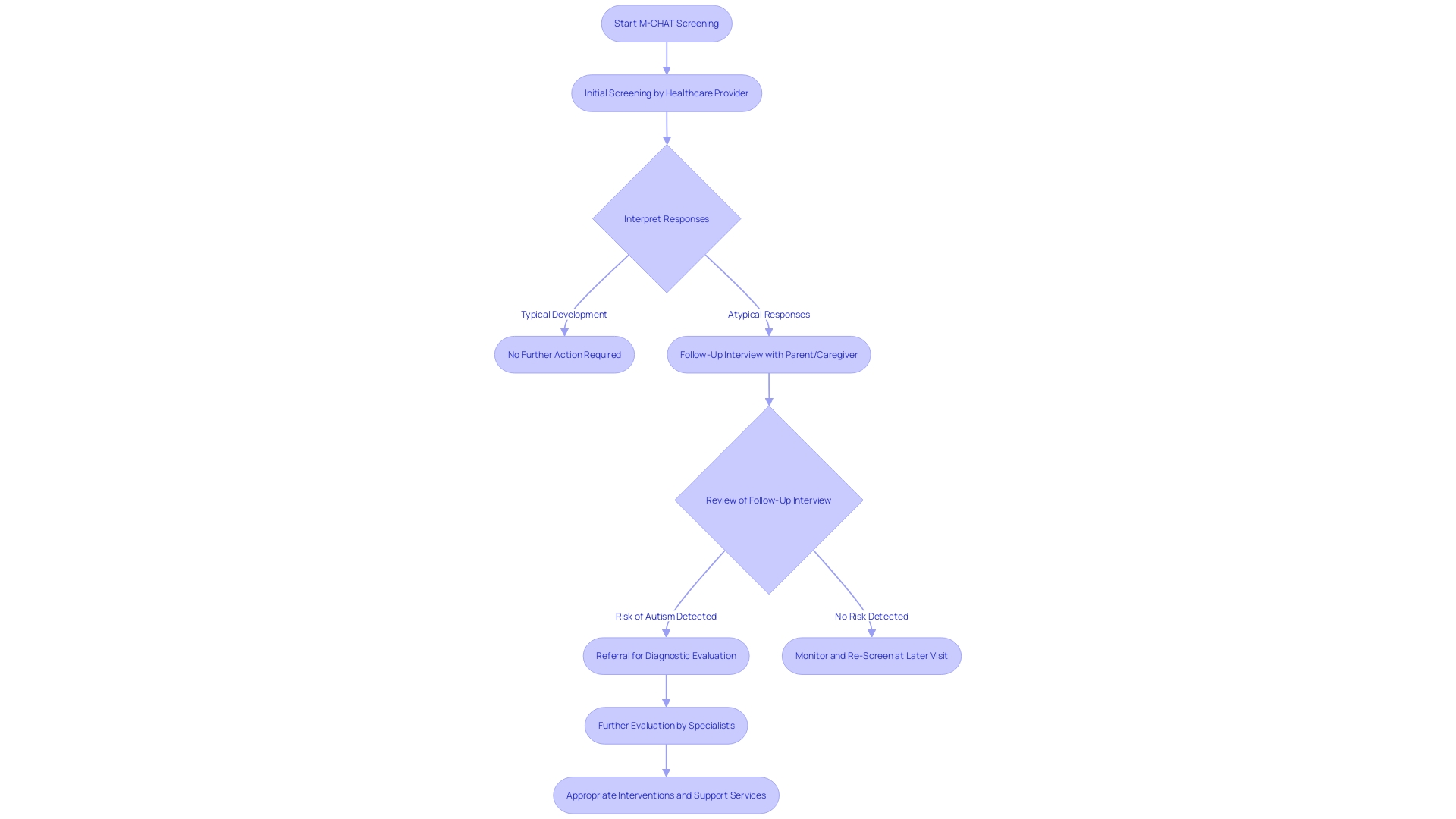
Interpret Positive and Negative Results
The Modified Checklist for Autism in Toddlers (M-CHAT) is a screening tool designed to identify children who may benefit from a more thorough developmental and autism evaluation. It can be a critical early step in the diagnostic journey, and understanding the results is key for parents and caregivers. A positive result on the M-CHAT doesn't diagnose autism, but it indicates a higher risk, suggesting that further evaluation is warranted.
Conversely, a negative result means a lower risk, though it's important to note that no screening tool is perfect, and ongoing observation of a child's development is essential.
Statistics highlight the importance of understanding M-CHAT outcomes. Approximately 30% of parents notice developmental concerns by 12 months, and by 24 months, that number rises to 80%. Despite these early concerns, the average age of autism diagnosis in the United States is between 4 and 5 years, pointing to a significant gap between initial worries and formal evaluation.
Moreover, a six-site study involving 496 children referred for autism assessments found that only around 70% of diagnoses were made with high certainty. This reality underscores the importance of M-CHAT results as a starting point for accessing early intervention services, which have been shown to improve various outcomes.
Digital tools are emerging as potential aids in the autism diagnostic process. Mobile apps and digital biomarkers offer scalable solutions and the ability to collect data in the child's natural environment, which can enhance the information available to clinicians.
It's essential to remember that the journey doesn't end with M-CHAT. As one expert puts it, autism is a spectrum condition affecting individuals differently. Therefore, following up on M-CHAT results with comprehensive evaluations and accessing appropriate resources can support the choices and opportunities needed to live fully, regardless of where a child falls on the spectrum.
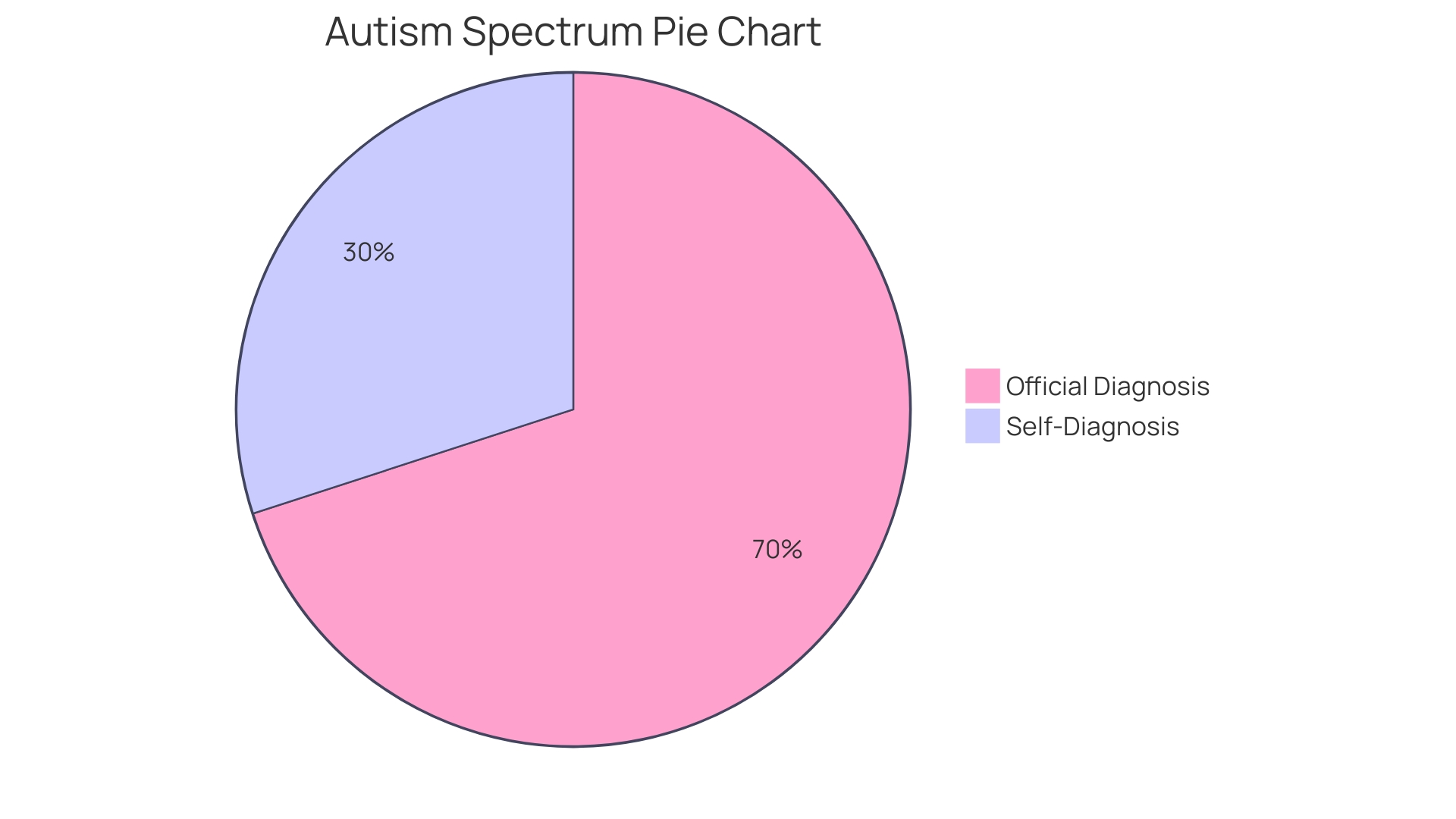
Consider the Advantages of the M-CHAT
The M-CHAT (Modified Checklist for Autism in Toddlers) serves as a practical screening tool for parents and professionals to identify early signs of autism spectrum disorder (ASD). This accessible tool, which can be utilized at no cost, is designed to pinpoint behaviors indicative of ASD in children as young as 18 months old. By answering a series of straightforward questions, parents can help to facilitate early detection of potential developmental concerns.
According to statistics, 30% of parents notice developmental concerns by their child's first birthday, and by 24 months, the number increases to 80%. Despite these early concerns, the average age of ASD diagnosis in the United States is between 4 to 5 years old, underscoring the need for effective early screening methods like the M-CHAT. Early intervention is critical, as research demonstrates that starting behavioral therapies as soon as possible leads to better outcomes.
Furthermore, in the digital age, tools like the M-CHAT not only streamline the initial screening process but also complement the digital biomarkers and technologies that are emerging in the field. These innovations offer scalable and accessible options for monitoring behavioral characteristics, potentially enhancing the diagnostic process and reducing the wait times for assessments, which can be emotionally and financially taxing for families.
As Autism affects 1 in 36 children, the importance of early and accurate screening tools cannot be overstated. The M-CHAT, by providing a cost-effective and easily administered method for early identification of ASD, stands out as a valuable first step in supporting the health, learning, and overall well-being of children on the autism spectrum.
Be Aware of the Limitations of the M-CHAT
While the M-CHAT (Modified Checklist for Autism in Toddlers) is widely recognized as a valuable initial screening tool for autism spectrum disorder (ASD), it's essential to acknowledge its limitations. The M-CHAT can produce both false positives and false negatives, which can lead to further stress and confusion for families. In the intricate journey of ASD diagnosis, no single tool should be the sole determinant.
The diagnostic process usually encompasses a combination of parental observations of their child's development and professional evaluation of the child's behavior, guided by the DSM-5 criteria.
Recent advancements in technology, such as digital health products like the SenseToKnow app developed by researchers at Duke University, demonstrate the potential of AI and digital biomarkers in enhancing diagnostic accuracy. SenseToKnow evaluates behavioral indicators in a child-friendly manner, using interactive games and eye-tracking to assess motor skills and other behaviors indicative of ASD. This approach not only aids professionals in their assessments but also offers parents a more comprehensive understanding of their child's unique profile.
Despite these technological innovations, it remains crucial that any concerns raised by screening tools are followed by thorough evaluations by specialists. These may include neurodevelopmental pediatricians, child neurologists, and early intervention programs. Studies have shown that the median age of ASD diagnosis in the U.S. is between 4 to 5 years, despite many parents noticing developmental concerns much earlier.
This delay underscores the importance of effective and timely professional evaluations following initial screenings.
In conclusion, while tools like the M-CHAT serve an important role in the early identification of ASD, they are just one part of a multifaceted assessment process. It's vital for parents and professionals to work together, leveraging both traditional assessments and innovative digital tools, to ensure accurate diagnosis and prompt access to supportive interventions.
Tips for Parents Considering the M-CHAT
When it comes to the Modified Checklist for Autism in Toddlers (M-CHAT) screening, a tool designed to identify children at risk for autism spectrum disorder (ASD), preparation and understanding are key. The M-CHAT is a critical early screening that can flag potential developmental concerns, paving the way for further evaluation and, if necessary, early intervention. It is typically administered during routine health visits as children reach 18 to 24 months of age.
As parents approach this screening, it's vital to recognize that the engagement and comprehension of your child can be greatly influenced by the content, organization, appearance, and writing style of the material provided. Utilizing multimedia tools, which have been successfully employed in patient education, including for children with intellectual disabilities, can be an excellent way to prepare your child for the screening process. These tools offer the advantage of allowing children to absorb information at their own pace in a familiar environment.
Research has documented that parents often struggle with how to disclose and discuss medical information with their children. The use of visual aids like pictures or books can be incredibly beneficial in making complex topics more understandable for young minds. Ensuring that the conversation about the M-CHAT and any potential follow-ups is developmentally appropriate is crucial.
Statistics show that early concerns about a child's development often arise before the age of 12 months, with increasing prevalence by 18 months and significant concerns by the age of 2 years. Yet, despite these early indicators, the median age of ASD diagnosis in the U.S. remains at 4 to 5 years. This fact underscores the importance of early screening like the M-CHAT and the role it plays in connecting families to support and services as promptly as possible.
Parents should approach the M-CHAT with an open mind and view it as a step toward understanding their child's unique developmental path. If the screening suggests further evaluation is needed, it's important to seek out reputable sources and expert guidance to navigate the subsequent steps. Remember, the goal of the M-CHAT is to initiate the journey toward the best possible outcomes for your child, and as a parent, you are not alone in this process.
Know the Next Steps After a Positive or Negative Result
After an M-CHAT screening, regardless of the result, it's crucial to understand the next steps in supporting a child who may be on the autism spectrum. If the M-CHAT outcome suggests possible autism, a formal evaluation by a professional is the next critical step. This evaluation, adhering to the DSM-5 guidelines, involves a thorough assessment of communication, social interaction, and behavior.
Early diagnosis, as the CDC estimates autism to occur in up to 1 in 36 individuals, is key to accessing tailored resources for living fully.
If the result is negative but concerns persist, or if the screening was inconclusive, similar steps should be taken. It's important to note that many in the neurodivergent community recognize self-diagnosis due to the challenges of obtaining a conclusive result through medical testing. However, a formal diagnosis can unlock essential early intervention services which have proven to dramatically improve outcomes, as affirmed by The Autism Community in Action (TACA).
Lastly, connecting with support networks, such as TACA, which assists thousands of families, can provide both immediate and long-term guidance. These networks can be crucial in navigating the complexities of autism and finding community and understanding in shared experiences. Embracing the diversity of autism as a spectrum condition with varied manifestations, from echolalia to intense interests, underscores the importance of a supportive and informed approach post-screening.
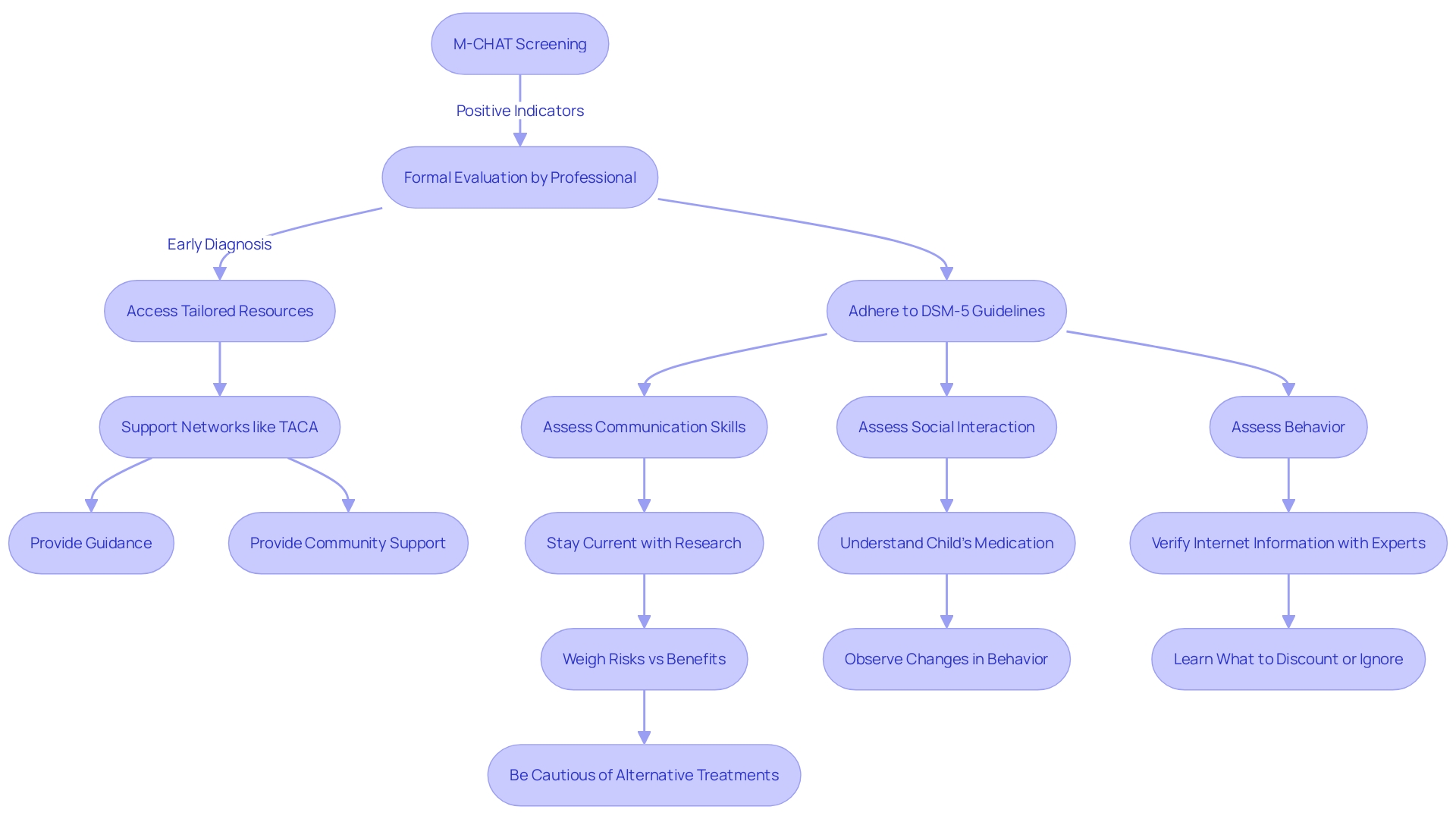
Highlight the Importance of Professional Evaluation
Navigating the complexities of autism diagnosis can be challenging, especially when considering the diversity of experiences within the autistic and neurodivergent community. For some, a formal diagnosis may not alter the support they need, leading to a broader acceptance of self-identification. However, for those seeking validation, clarity, and access to specific resources, a professional diagnosis following screenings like the M-CHAT can be crucial.
While the community acknowledges the limitations of current medical testing, with many adults receiving inconclusive results, the pursuit of a formal diagnosis can strengthen one's understanding of their identity and facilitate acceptance among peers.
Even with the openness towards self-diagnosis, the significance of a professional evaluation cannot be understated. It paves the way for early intervention, which is associated with better outcomes. For example, research published in the Journal of the American Medical Association emphasized the predictive power of children's looking behavior during screenings and the potential for early, accurate diagnoses through innovations like NeuroQure's technology.
The statistics are stark: only around 70% of young children referred for autism evaluations receive a diagnosis with a high level of certainty, highlighting the importance of precision in the diagnostic process. Experts such as neurodevelopmental pediatricians and child neurologists, utilizing tools like the ADI-R, look beyond initial screenings to assess a range of behaviors. This comprehensive approach is essential for capturing the nuanced presentation of autism and ensuring that families can access the early behavioral therapies crucial for fostering development in language, cognition, and social skills.
Ultimately, the decision to pursue a formal diagnosis is deeply personal and varies from individual to individual. For those who choose this path, it's not merely about the label but about embarking on a journey toward self-understanding and equipping themselves with the necessary tools to navigate their unique experiences within the spectrum.
Address FAQs About M-CHAT Screening
Understanding the M-CHAT (Modified Checklist for Autism in Toddlers) screening tool is paramount for parents seeking clarity about their child's development. The M-CHAT is a widely recognized early screening tool for autism spectrum disorder (ASD), designed for use with children as young as 16 months. Its primary purpose is to identify children who should receive more intensive assessment or evaluation for potential ASD.
The screening involves a series of questions related to the child's behavior, such as their ability to make eye contact, respond to their name, and engage in pretend play. It's important to note that the M-CHAT is not a definitive diagnosis tool but rather a preliminary step to determine if further evaluation is warranted.
Recent research underscores the importance of early screening. Data shows that 30% of parents of children with autism had concerns before their child reached 12 months, and by age 2, 80% of parents had concerns. Despite these figures, the median age of autism diagnosis in the U.S. remains between 4 to 5 years.
Early identification through tools like the M-CHAT can lead to earlier intervention, which is vital since early support and services can significantly benefit a child's long-term development.
A common misconception about the M-CHAT is that it's a one-time, conclusive assessment. In reality, follow-up questions or additional evaluations may be necessary for a comprehensive understanding. The US Preventive Services Task Force (USPSTF) emphasizes the need for individualized decision-making in healthcare, highlighting that clinical decisions should extend beyond evidence alone, factoring in the unique circumstances of each patient.
With advancements in digital health, including mobile apps and digital biomarkers, there are new opportunities for enhancing the autism diagnostic process. These tools can provide clinicians with ecological information from a child's home environment and help to streamline the path to diagnosis, which can be critical in mitigating the impact of diagnostic delays on quality of life and the development of comorbidities.
In summary, while the M-CHAT is a critical component of early autism detection, it is the first step in a journey that may involve multiple assessments. It's essential for parents to engage in open dialogue with their healthcare providers to understand the results and the best course of action for their child.
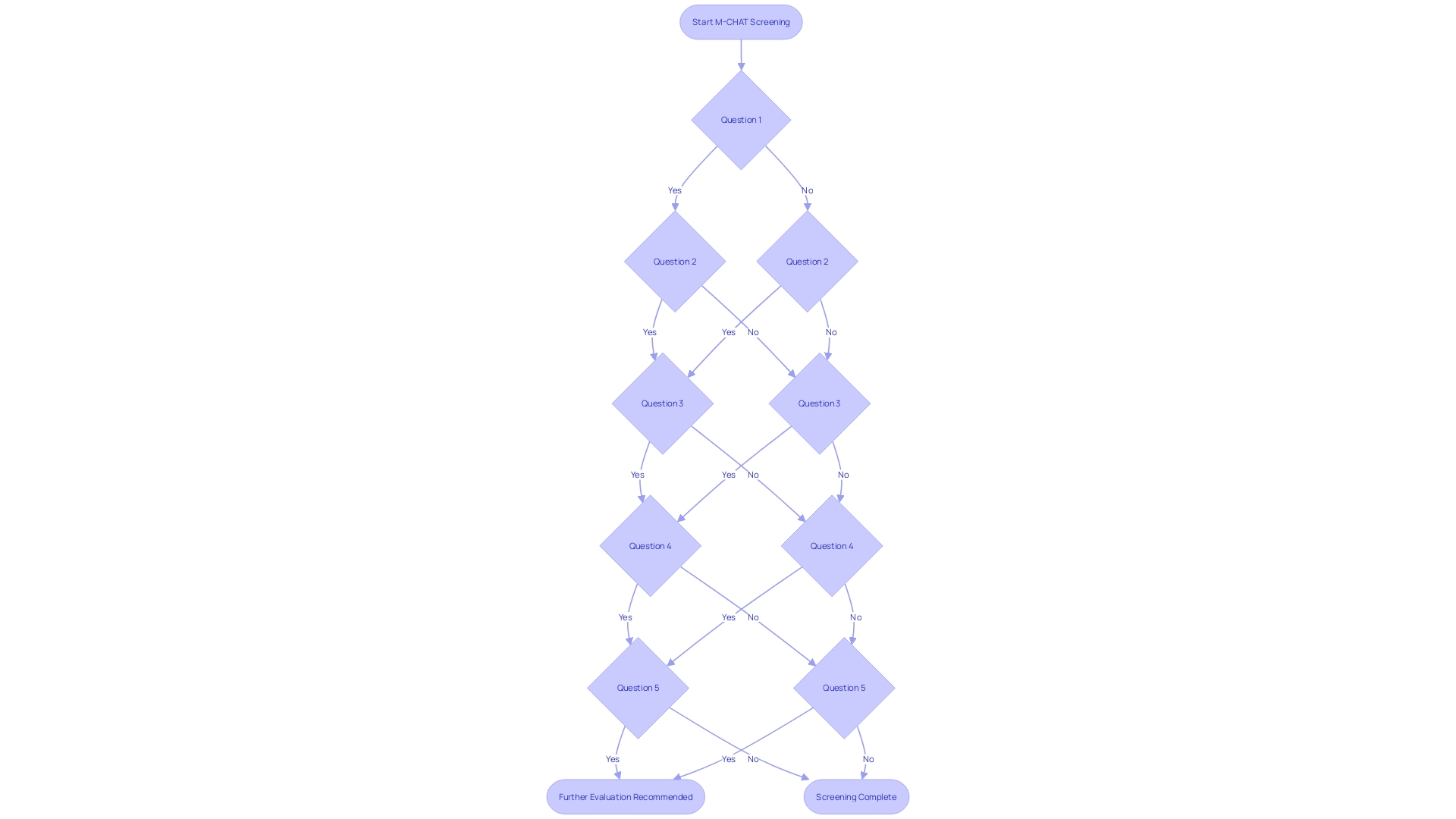
Provide Additional Resources and Support
Parents navigating the path of autism screening and seeking additional information and support can find solace in a variety of resources. The journey to understanding and embracing a child's neurodiversity can be complex and daunting, but numerous organizations offer a helping hand. Through the Looking Glass (TLG), a Berkeley-based nonprofit, leads the way with services tailored for families where disability plays a role in their daily lives.
Their mission is rooted in the belief that resources should empower and reflect the lived experiences of the disability community.
For a comprehensive look at their offerings, exploring their webpages dedicated to services for families and children with disabilities could prove invaluable. They cover a spectrum of needs from early intervention to support for parents and grandparents with disabilities. Additionally, the National Disability Insurance Scheme (NDIS) in Australia provides critical funding for disability-related services, ensuring that children with autism receive early intervention tailored to their unique needs and goals.
Dr. Zafar Rasheed, an authority on autism in Australia, emphasizes the importance of early detection and intervention, which are cornerstones for achieving better outcomes for children with autism. With a growing awareness, Australia has made significant strides in providing support and services, yet challenges in diagnosis and access to appropriate interventions persist. It's imperative for caregivers to remain informed and proactive in seeking out the newest findings and treatments, as underscored by author Kelley Coleman, who provides guidance through her own experiences as a parent.
By staying engaged with credible organizations, such as TLG, and keeping abreast of the latest research and developments, parents can ensure they're equipped with the knowledge and support necessary to advocate for their children's well-being and inclusion in all aspects of life.

Encourage Regular Follow-Ups and Monitoring
Ongoing monitoring and regular follow-ups are crucial steps in supporting a child's developmental journey post the preliminary Modified Checklist for Autism in Toddlers (M-CHAT) screening. Continuous assessment plays a pivotal role in the early identification of developmental concerns, allowing for timely interventions that can significantly improve outcomes for children with developmental delays or disorders.
The US Preventive Services Task Force (USPSTF) advises that clinicians should not solely rely on initial evidence but continue to tailor their decision-making to each child's evolving needs. Furthermore, research underscores the increased risks that children with speech or language delays face, including heightened chances of learning and literacy disabilities, as well as social and behavioral challenges that can extend into adulthood. These findings highlight the necessity of persistent evaluation and the evaluation of children's developmental progress.
Supporting the importance of early and ongoing intervention, The Autism Community in Action (TACA) advocates that early treatment, such as behavioral therapy, leads to more favorable outcomes for children with autism. This is echoed by NeuroQure's mission to provide early and precise diagnosis to expedite support for families, underlining the transformative impact of early detection and the subsequent care provided.
The commitment to equitable health care, as championed by the USPSTF, emphasizes the need to address the effects of systemic and structural biases on health outcomes. This approach aligns with the vision shared by child psychiatrist Dr. David (Dan) R. Offord, who emphasized the importance of fair and supportive conditions for the mental health of all children, particularly those with disabilities.
In light of these perspectives, regular follow-ups and ongoing monitoring serve not only as a means to support children's development but also as a commitment to fostering an equitable and supportive environment that caters to the unique needs of each child, ensuring that no child is left without the care and attention they deserve to thrive.

Promote Awareness and Advocacy
Parents play a pivotal role in championing early detection and intervention for autism, which is crucial for the mental health and equitable treatment of children with disabilities. By actively sharing their experiences and advocating for readily available screening services, parents can contribute to a fairer start for all children, including those with autism spectrum disorder (ASD). This involves acknowledging the unique strengths and needs of children with disabilities, minimizing chronic stressors, and ensuring families have the necessary support for their child’s growth and the family's overall well-being.
The intersection of open science and community engagement, as demonstrated during the pandemic, can lead to remarkable advancements in autism research and services, benefiting not just the scientific community but also families affected by ASD.
The Autism Community in Action (TACA) exemplifies the power of early intervention, showing that starting behavioral therapy as soon as possible leads to better outcomes. With the development of new diagnostic tools by companies like NeuroQure, the lengthy and often distressing process of obtaining an ASD diagnosis could be dramatically reduced, especially for families with a higher risk. This progress aligns with the efforts of the Interagency Autism Coordinating Committee (IACC) to foster collaboration and communication that advances autism research and services.
Staying informed about the latest treatments, risks, and benefits of medications is a responsibility that caregivers shoulder. Validating information with experts is essential, as is discerning between credible research and misleading online narratives. The commitment to ongoing research and resource sharing, as outlined by the Individuals with Disabilities Education Act (IDEA) and other early childhood programs, emphasizes the importance of individualized programming and inclusion from the earliest ages.
This collective effort ensures that children with disabilities receive the support and opportunities they deserve to thrive in society.
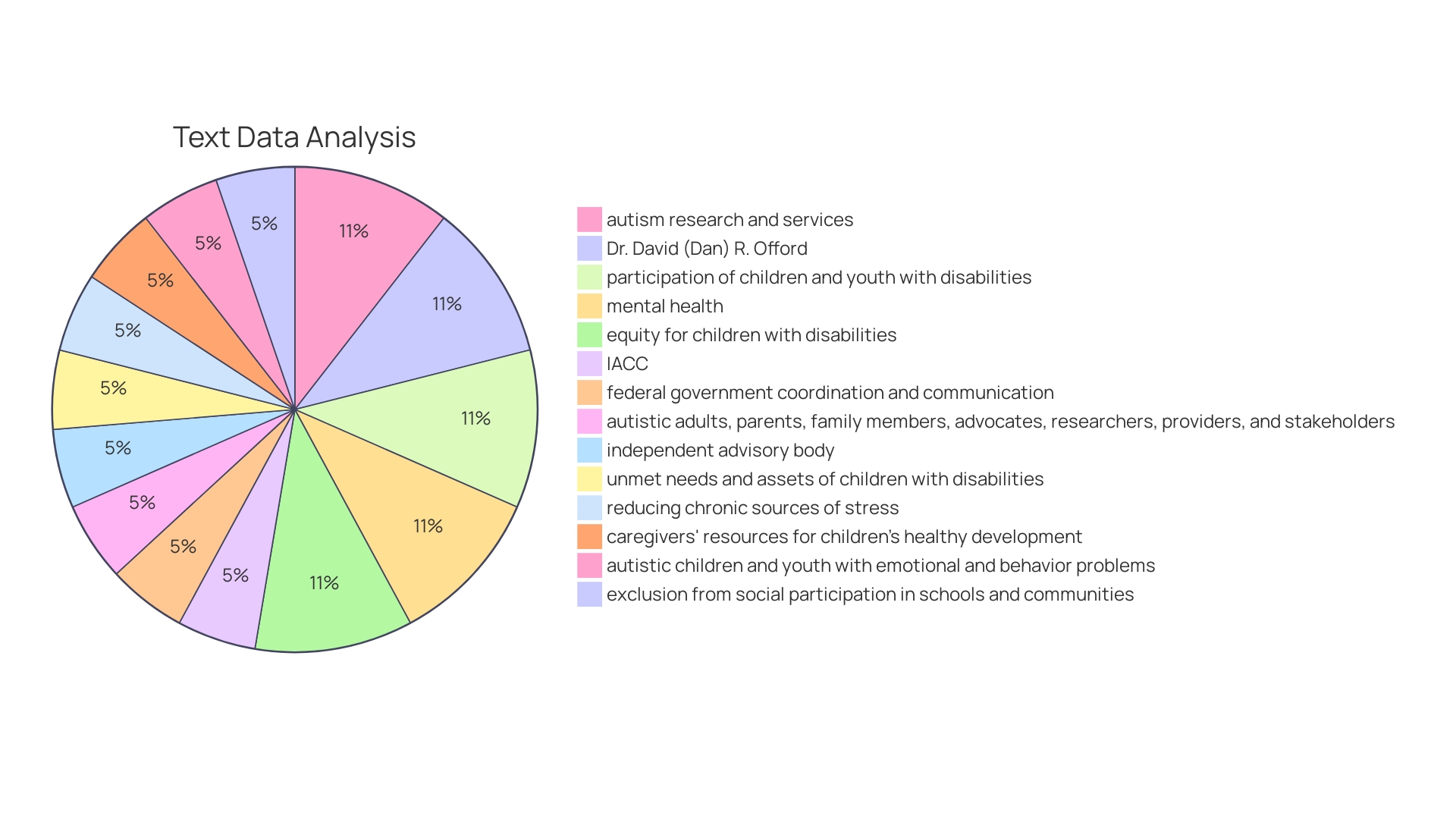
Celebrate Progress and Success Stories
Celebrating triumphs in early autism intervention is paramount, as these victories illuminate the path forward for parents and children alike. Consider the story of Sergio, a child who, once isolated in silence, found his voice thanks to the dedicated efforts of his speech therapist and foster mother through the Inclusive Education Unit in Moldova. Sergiu's journey from nonverbal communication to self-introduction is a testament to the power of early intervention and specialized support in mainstream education.
The significance of early detection cannot be overstated. A study involving 496 children across six specialized centers revealed that early behavioral therapies catalyze improvements in language, cognition, social interaction, and adaptive skills. However, the study also highlighted a sobering reality: about one-third of autism diagnoses in young children carry uncertainty.
This uncertainty often delays access to critical interventions for children, especially those with milder symptoms or higher cognitive abilities.
Research underscores the impact of addressing autism's core challenge: social communication. By focusing on preverbal social communication like joint attention, which considers the partner's interests and perspectives, children are given a compelling reason to communicate, paving the way for verbal skills.
Innovative diagnostic tools are on the horizon, such as the 'Marcus Test,' which predicts autism by analyzing eye movements in response to social interactions. This breakthrough technology promises earlier diagnosis and, consequently, timelier intervention.
The narratives of children like Sergiu and technological advances like the 'Marcus Test' offer a beacon of hope. They serve as reminders that with the right resources and timely intervention, children with autism can experience transformative progress, reshaping their futures and enriching their interactions with the world around them.
Stay Informed and Updated
Staying abreast of the latest advancements and resources in autism research can significantly impact the lives of those on the autism spectrum and their families. The Interagency Autism Coordinating Committee (IACC) plays a pivotal role in this by working to enhance collaboration across federal agencies and partnering with the autism community, including parents, advocates, and autistic individuals. Their efforts aim to foster a well-informed society that can offer the best support to individuals with autism.
The poignant words of Dr. David (Dan) R. Offord remind us that equity in the support provided to children with disabilities, including those with autism, is crucial for their mental health and well-being. These principles are echoed by The Autism Community in Action (TACA), which aids thousands of families and emphasizes the importance of early and accurate autism diagnosis for effective intervention.
Moreover, recent news from NeuroQure highlights the urgency for early detection tools, with their innovative approach potentially revolutionizing the diagnostic process to identify autism spectrum disorder (ASD) within weeks of birth.
It is essential for parents and caregivers to have access to reliable, evidence-based information. They can benefit from subscribing to publications and updates from reputable organizations such as the IACC and TACA, which offer insights into intervention goals, procedures, and outcomes. This empowers them to support their children's development and advocate for their rights, especially in educational settings where inclusion is crucial.
With the diagnosis of ASD involving a multi-disciplinary approach, the National Disability Insurance Scheme (NDIS) in Australia provides a model for personalized support plans, emphasizing the significance of early intervention programs that tackle communication, social skills, behavior management, and sensory processing.
In conclusion, by aligning with organizations that monitor and transparently communicate the latest research and resources, parents can ensure they are providing the most informed support for their children with autism.
Conclusion
In conclusion, the Modified Checklist for Autism in Toddlers (M-CHAT) is a valuable screening tool for early detection of autism spectrum disorder (ASD). Despite its limitations, the M-CHAT plays a crucial role in identifying developmental concerns and initiating timely interventions.
Early screening is essential for accessing the necessary resources and support for a child's well-being. Positive M-CHAT results indicate a higher risk for ASD and should be followed by a professional evaluation. Negative results do not rule out the possibility of ASD, and ongoing observation is important.
Parents should be proactive in seeking evaluations and accessing appropriate resources for their child's unique developmental journey. Engaging in follow-up interviews and comprehensive assessments provides a comprehensive understanding of their child's abilities and challenges, leading to tailored interventions.
Staying informed about advancements in technology, such as digital biomarkers, can enhance the diagnostic process and provide valuable information from a child's natural environment.
Regular monitoring and follow-ups are crucial for supporting a child's development and addressing evolving needs.
Accessing additional resources and support organizations empowers parents to navigate the complexities of autism and ensure their child's well-being.
Celebrating progress and success stories in early autism intervention inspires hope and encourages continued efforts in supporting children with autism.
In summary, the M-CHAT serves as an important screening tool for early detection of ASD. By being proactive, staying informed, and accessing appropriate resources, parents can advocate for their child's well-being and ensure timely interventions for their unique developmental journey.




